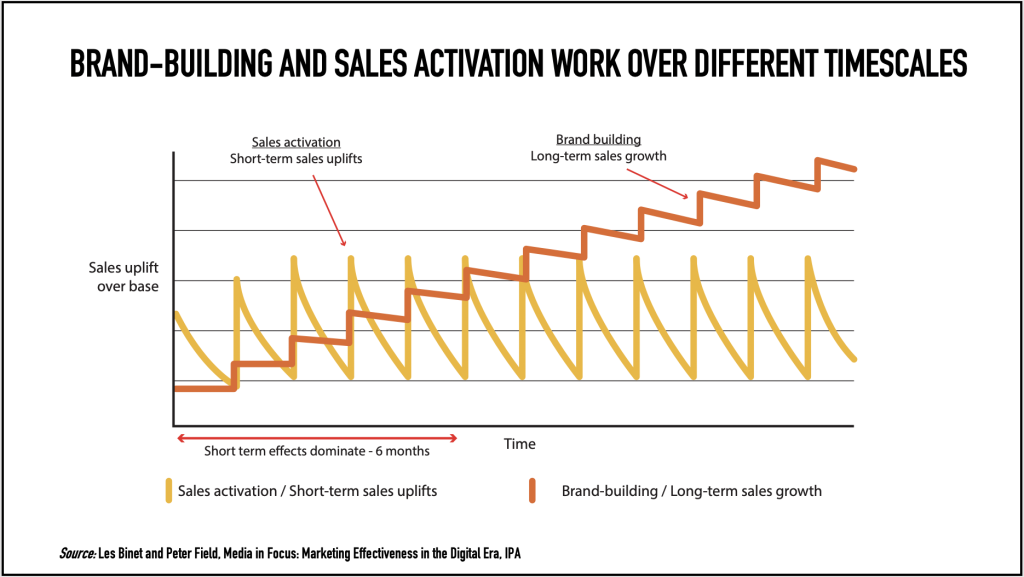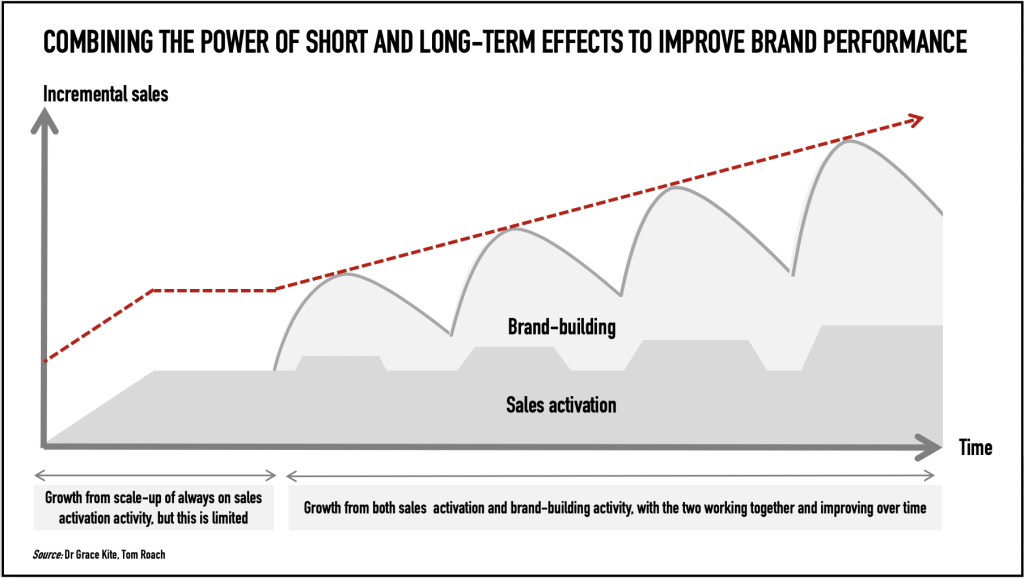Tom Roach on the value-destroying divide between ‘brand’ and ‘performance’ marketing

Award-winning marketing strategist Tom Roach, explains how to get long and short-term marketing tactics working in harmony, and reap the rewards.
Short-termism and long-termism are both just wrong-termism – so says multiple Gold IPA Effectiveness award-winning marketing strategist Tom Roach.
Roach, who has worked at some of the best communications agencies in the world (Leo Burnett, BBH, adam&eveDDB and, most recently, Jellyfish), proposes ending the false choice between long and short-term marketing tactics. Here, he explains how to get the two working in harmony, and close the value-destroying divide between ‘brand’ and ‘performance’ marketing…
The wrong & the short of it
It may seem a little unnecessary for yet more words to be written about the long and short-term in marketing given two industry legends have literally already written the book on it. But whilst the theory says we should all try to achieve a balanced approach in order to maximise both saleability and sales simultaneously, there’s a massive gulf between the theory and the actual practice, which is increasingly divided between practitioners of ‘brand’ and ‘performance’ marketing.
Short-termism
There are irresistible pressures pulling marketers towards the short term. And there’s also a huge asymmetry in terms of accessibility to ‘performance’ channels vs ‘brand-building’ channels.
Google, Facebook, Amazon and other platforms have given millions of businesses of every size and type, easy, self-service access to a giant direct response advertising ecosystem. And this universal accessibility is also ensuring there’s a ready and growing supply of ‘performance’ marketing specialists and a dwindling supply of ‘brand’ marketing specialists – a factor that further exacerbates the divide.
Long-termism
There’s always been a lot of magical thinking about the long term in advertising. That you can just do something big and expensive as a one-off, then close your eyes and cross your fingers and hope no one commercially-oriented asks any awkward questions for six to twelve months, until future sales start magically happening.
But communications that are successful over the long term don’t work by activating some kind of ‘sleeper cell’ in buyers’ minds which suddenly bursts into frenzied commercial action after many months of lying completely dormant – communications need to achieve some level of short-term sales success as well as improving a brand’s mental availability if they’re also going to achieve long-term growth.
Wrong-termism
And whilst they’re quite different, it’s possible to simultaneously see short-termism and long-termism as equally bad practice – wrong-termism, if you will. Wrong-termists get it wrong in two different ways: short-termists restrict the long-term growth their marketing can achieve, and long-termists restrict its short-term sales impact.
The long through the short of it
It’s never been more important to make every marketing $ work as hard as it possibly can. After all, without short-term success there may not even be a long-term for some of our brands. And the best way of securing both will be to embrace the fertile middle-ground that lies in combining the power of short and long-term effects.
Long-term growth always has its roots in the short term. The two are connected, influence each other, and if you get the two working perfectly in harmony together, you’ll achieve the strongest, most sustainable growth possible.
But we so often miss out on maximising growth in this way because of our binary belief systems, the organisational silos we inhabit, the different job titles we have, the different channels and formats we tend to use and the different metrics we try to optimise.
It’s important to say that long-term growth isn’t just achieved by adding up a series of short-term effects. It’s more complicated than simply being additive: it’s a multiplicative, compound effect, which starts slowly but strengthens over time.
And whilst all long-term growth actually has roots in the short term, only some kinds of short-term activity also lead to long-term results. So the roots of long-term growth are there in the present if you do the right kind of marketing communications.
Brand-building and sales activation work over different timescales
It’s practically the law that any discussion of the long and short-term in marketing must include Binet & Field’s classic ‘steps’ chart illustrating the two different ways in which communications can drive sales – through short-term sales activation and long-term brand-building, so here it is:

Now find below an illustration by econometrician Grace Kite and me, building on the classic ‘steps’ chart. It’s from the perspective of a common real world scenario; that of a digital-first brand whose initial strong growth from always-on performance activity has levelled off. After which point, brand-building activity is successfully deployed in order to take growth to the next level. It’s based on the econometric modelling Grace has done for a wide range of brands facing similar challenges.

The chart shows growth initially being driven by always-on activity in performance channels, and the impact of that activity reaching a plateau, which often happens when saturation point is reached. Then it shows the impact of a successful decision to layer in ‘brand-building’ activity.
Note that this brand activity both delivers its own short and longer-term sales impacts, as well as improving the sales generated by performance channels. It also shows the compound effects of all this marketing activity working together and becoming stronger over time as the brand-building activity is further optimised.
Time to start closing the divide
I believe it’s never been more important that we start closing the artificial but growing divide between brand and performance marketing, and to do what’s most effective for our brands collectively.
Brands should be aiming to create long-term communications engineered for immediate success. Advertising that, in the words of the great Jeremy Bullmore, sells ‘both immediately and forever’. Let’s all make that our ambition too.
Want to learn more about Tom Roach’s strategy for maximising marketing effectiveness? Don’t miss our upcoming webinar. Sign up below!
To read the full, unabridged version of this blog visit thetomroach.com
Tell us what you think of this article by leaving a comment on LinkedIn.
Or share it on:

